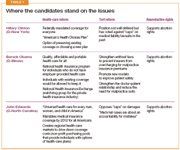Election 2008: Where do the Democratic candidates stand?
Dr. Charles Lockwood outlines the Democratic candidates and where they stand on health-care reform, tort reform, and reproductive rights.

My passion for things political has only deepened as I've watched the current health-care crisis develop over the past several years. The latest 2006 census data indicates that the percentage of uninsured Americans increased from 15.3% in 2005 to 15.8% in 2006 and the number of uninsured increased from 44.8 million to 47.0 million.1 As ob/gyns we should be at the forefront not only of mandating universal access to prenatal care, but of routine preventative heath care for women. In addition, we should be concerned that over the past several years there have been repeated failures of tort reform efforts in both Congress and many state legislatures, including my own. Ironically, the politicians who support tort reform are often at odds with most ob/gyns on the issue of reproductive choice. The good news is that health care itself is on the minds of all Americans. In a December 2007 Kaiser Family Foundation poll,2 health care ranked second only to the war in Iraq as an issue that the American public wanted to hear presidential candidates discuss.
IT'S IMPERATIVE FOR OB/GYNS to stay informed on the positions that the various candidates have taken on important issues related to our field. In this way, we can make better decisions as we cast our ballots in the primaries and ultimately in November 2008. With that in mind, I plan to devote the next two editorials to presenting an objective compilation of Democratic and Republican candidates' positions on health-care financing reform, tort reform, and reproductive rights. Because several candidates will be rapidly weeded out in the next few months, let's focus on the three candidates polling more than 10% at the start of the New Year.3
Sen. Clinton is probably the best-known candidate when it comes to health-care reform.

Under the Clinton plan, Americans would have the same health plan options that members of Congress receive through the Federal Employee Health Benefit Program. People would choose from several private insurers as well as a new public insurance plan modeled after Medicare. The proposal offers a tax credit to limit the amount an individual pays in premiums to a certain percentage of income and provides small business tax-credits. The program would be paid for by eliminating the Bush tax cuts and reducing waste and inefficiencies in the current system.3,4
Sen. Clinton supports abortion rights and has voted in favor of a woman's right to choose. She also believes strongly that education about birth control and sex education in general will lead to fewer unwanted pregnancies.4,5
